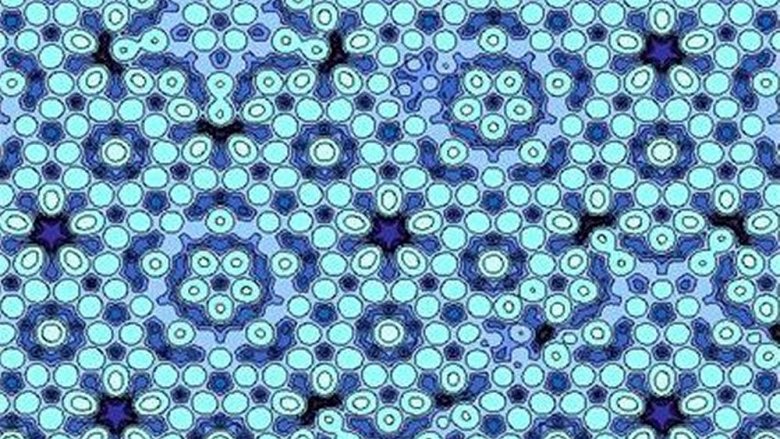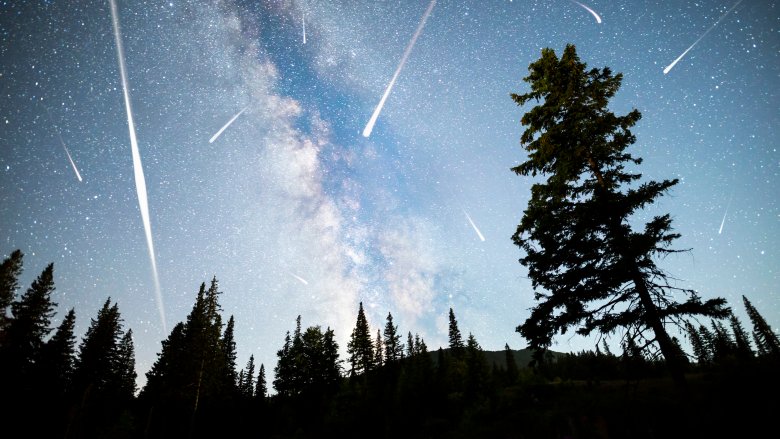Real Phenomena That People Used To Think Were Fake
Back in the day, people believed in some funny things. Seriously, go back a few centuries, and you'll find ordinary folks thinking that every shot of sperm contained a tiny, pre-formed human inside. Not silly enough? How about the popular belief that mice "spontaneously generated" from mud? Yeah, that didn't age well.
Now, that doesn't mean these folks were stupid. Honestly, give it a few decades, and everybody today will look stupid, too. Perhaps the craziest thing, though, are those moments in history where some crazed genius pops up out of nowhere, points to a scientific truth ... and the establishment shreds them to pieces. Remember what happened to Galileo when he was audacious enough to point out that the Earth rotated around the sun? Not pretty. Heliocentrism has hardly been the only scientific reality that got mocked in its time, sadly, and the world is full of all-too-real phenomena that people used to think were fake.
Ball lightning is a super freaky phenomenon
The notion that glowing orbs of electricity can generate from thunderstorms, move through walls, and even kill people sounds like something from the latest Thor movie, but nah, it's a real phenomenon. It's called "ball lightning," according to HowStuffWorks, and the cool kids have been talking it up for centuries. Just ask the ancient Greeks. People in the Middle Ages witnessed it, too, and while those folks weren't the most reliable (they also believed in dragons), ball lighting was also reported in the 1800s by a young Czar Nicholas. Then there's Georg Richmann, the famed electricity pioneer, who's believed to have been killed by one of these luminescent death orbs.
Now, given how insane and supernatural ball lightning sounds, you can't blame people for yawning, snickering, and rolling their eyes at these reports. Experts wrote it off completely until 1963, according to Nature, when — finally! — an honest-to-goodness scientist got involved. This dude, Robert Clifton Jennison, was riding a red-eye flight from New York to Washington. As the plane passed through a thunderstorm, one of these freaky electric balls emerged from the cabin, floated down the aisle, and vanished. Nightmare fuel? Sure, but also fascinating, so Jennison decided to study, you know, whatever the heck he'd just seen. Since then, ball lightning has been openly examined, theorized about, and even recreated in a lab. As for why it happens? That's still being figured out, according to National Geographic, but theories abound.
Cataclysmic floods can really happen
Every culture has its own flood myth. You've certainly heard of Noah and his ark, but there's also a version in Hindu mythology, a Mesopotamian version, as well as a flood in North American indigenous legends, just to name a few. While there's probably no way that a single flood could've decimated the globe, you wouldn't be the first person to propose that certain countries might've experienced their own so-called "cataclysmic floods" — i.e., floods capable of sinking entire geographic regions — as an explanation for these myths.
However, back in the 1920s, geologists thought cataclysmic floods were a bunch of crock, according to Discover Magazine. They considered the notion so ridiculous, in fact, that when a guy named J Harlen Bretz claimed that he'd found evidence that one such flood had sunk the state of Washington about 15,000 years ago ... well, let's say they laughed him out of the room. To them, Bretz's apocalyptic vision of Washington being buried beneath waters over 100 feet high sounded more like fanaticism than science.
Here's the thing, though. Bretz was right, and he knew he was right. As he dug through dried up waterfalls and bizarre granite boulders, he pieced together that this great flood had originally spilled out of Montana's Lake Missoula, and a few decades later, further studies showed that his "Missoula Floods" had really happened. The best part? Once Bretz's work was vindicated, other geologists located similar evidence of various cataclysmic floods from around the world. Flood myths, explained!
Everybody thought reptile dreams were fake
All animals have to sleep sometime, right?
Surprisingly enough, The Washington Post says that's been a matter of some debate. Until recently, it was widely believed that most animals, other than mammals and birds, don't actually "sleep" in the way that humans define it, but instead, they simply "rest." Insects and amoebas, for example, might slow down and reduce their activity, but there's been no evidence that they experience the same restorative, REM states that mammals and birds enjoy. That's not sleep, and hence, they don't have dreams.
And for a long time, scientists thought that humankind's scaly friends, the reptiles, couldn't dream, either. That notion got rocked in 2016, as reported by Scientific American, when a sleep study was performed on five Australian bearded dragons. Probes were placed inside their lizard brains, and it was found that each of the little green guys experienced REM sleep cycles nightly, making it highly probably that — bizarre as it sounds —these lizards also probably experience dreams. This was a big surprise to researchers, and even more intriguingly, it points toward the notion that reptiles and birds probably shared common ancestors who also had dreams. Unfortunately, there's no way to go back and ask a Tyrannosaurus Rex what kind of dreams it had, but you can probably wager that they involved meat, sun, teeth falling out, or weird insecurities about having such tiny arms.
Sound the alarm, the continents are moving!
In the early 20th century, according to Smithsonian.com, a German meteorologist named Alfred Wegener proposed the idea that all of Earth's continents, which seem so static, were actually just moving fragments of a prehistoric supercontinent he named Pangaea. This hypothesis, called continental drift, is now accepted science. Back when Wegener was alive, though, his concepts and character were torn apart by the establishment, like a hungry pack of coyotes lunging for the best bits of meat. The big problem, as one geologist so unintentionally pointed out, was that believing Wegener's theory undid everything that geologists had built over the past 70 years, requiring a near-total reset. Not fun! And so, instead, continental drift was written off as "delirious ravings." An American paleontologist referred to it as "Germanic pseudo-science." Who was this strange little man, trying to claim that the ground beneath a person's feet was perpetually moving? How were those things moving, huh?
So basically, everybody thought this guy was a kook, and those who suspected otherwise wanted him to be a kook. Rather than crumbling under the criticism, though, Wegener used it to refine his theory, correcting all his mistakes, and advancing forward. In the 1960s, a new generation of geologists unseated the old guard, and were far more open to Wegener's ideas. Unfortunately, by that time, it was already too late for Wegener to see his own exoneration. In 1930, while making a lifesaving delivery of food to meteorologists stranded in Greenland, Wegener died.
Ulcers are caused by bacteria, not stress
What causes ulcers? Until the 1980s, everyone in the medical community would've told you that they were brought about by stress, according to NBC News. And hey, that's believable enough. Stress does horrible things to the mind, the body, and your overall health.
However, when Australian pathologists Barry Marshall and Robin Warren began working together in 1981, they came to a different conclusion about ulcers. They believed their onset was caused by bacteria in the stomach. A bacterium named Helicobacter pylori, to be precise. Their theory didn't go down well with the establishment. At the time, medical schools taught that the stomach was a pool of sterile, corrosive juices, unable to grow bacteria of any kind, so the men's findings were dismissed. However, Barry Marshall was convinced, and like Bruce Banner bombarding himself with his own gamma rays, Marshall made the fateful decision to concoct a drink, filled with Helicobacter pylori germs, and gulp it down. Yikes! Sure enough, the brilliant and brave scientist came down horribly sick, thereby proving his point. Dramatic evidence, for sure, though perhaps a bit less dramatic than hulking out into a green monster.
Anyhow, this impromptu experiment completely altered science's perception of ulcer disease. The two men were righteously awarded a Nobel prize in 2005.
Big earthquakes trigger little earthquakes across the world
Big earthquakes leave a big impact. That's all thanks to "remote triggering," a scientific reality established after 1992, when a massive, 7.3 magnitude earthquake in California sent smaller tremors rumbling all the way into Yellowstone National Park. Back then, the scientific community balked at the notion that colossal earthquakes could trigger smaller ones — particularly if those smaller earthquakes occurred on the other side of the planet, or in areas not prone to quake activity — but a 2008 study by the University of Utah proved that the impossible was all-too-possible. The researchers examined multiple instances of remote triggering, caused by 15 major earthquakes from 1992 through 2006. Most notable of these, perhaps, was the horrifying 2004 earthquake in Sumatra, which remotely triggered quakes in Ecuador, literally on the opposite side of the planet. That's a long reach, no?
Remote triggering has since become a hot topic for experts, according to New Scientist, and it's even been estimated big quakes cause other quakes at least nine percent of the time. Whoa! Maybe that also explains why id Software's Quake games keep spawning new Quake sequels, eh?
Quasicrystals were considered an impossible phenomenon
In 1982, an Israeli chemist named Daniel Shechtman was shocked to observe something which, by all scientific measures known at the time, couldn't exist.
His discovery of a crystal displaying fivefold symmetry (as seen above) defied explanation, according to Britannica. At the time, it was believed that crystals could only possess two, three, four, or sixfold symmetries, since a fivefold symmetry would seemingly not be able to provide the necessary repeating structure. Shechtman's crystal, in fact, did not repeat, rendering it "aperiodic," and thus it was even more impossible. His bizarre finding, now referred to as quasicrystals, contradicted with established science dating back to the 1890s, and as The Jerusalem Post points out, Shechtman was villainized, mocked, and even ousted from his research group. It took two years for him to publish his discovery, at which point one American chemist, Linus Pauling, dismissed him by stating, "There are no quasicrystals, only quasi-scientists." Ouch.
Except Shechtman had it right, and quasicrystals were real. In 1987, French and Japanese scientists were able to produce quasicrystals big enough to be examined with X-rays, redeeming Shechtman's reputation. A few decades later, in 2011, the former "quasi-scientist" was awarded a Nobel prize. Take that, doubters.
Einstein's theory of relativity bumped against common knowledge of the time
Listen, Albert Einstein's messy white hair might now be the worldwide symbol of scientific brilliance, but it wasn't always that way. Back in 1905, a rather young version of the legendary theoretical physicist published a paper on "special relativity," according to JSTOR Daily, proposing that space and time were linked together. Now, this paper was the direct predecessor to his now-famous theory of general relativity. Without getting into the nitty-gritty, this was where he stirred gravity into the recipe. However, while Einstein's later work has been accepted as one of the most important scientific theories ever — and, as USA Today points out, his work keeps getting re-confirmed today — the establishment of 1905 was a lot more skeptical about the guy.
See, back then, everybody was convinced that space was filled with this bizarro substance called ether. Widely considered the fifth element, ether was theorized to be the "solid" that filled all the nothing, but ... uh, wasn't detectable. Right. Think "ethereal," and you'll get the idea. Anyway, whatever ether was believed to be, Einstein's theory directly contradicted its existence, so other scientists scorned his work as "totally impractical and absurd."
However, when Albert Einsten pointed out that there was no evidence for ether, he was right. These days, sure enough, Einstein's theories are the law of the land. The only place you'll find ether is ... well, in the ether.
Once upon a time, scientists didn't believe in meteorites
Meteorites seem like an obvious reality. However, just imagine for a moment if someone told you — in an era before iPhones, before Wikipedia, before cameras — that they'd seen a glowing space rock shoot out of the sky. Sounds stupid, right? After all, throughout history, people have claimed to see all kinds of wacky junk raining down from the clouds, including blood, animals, and milk.
Meteorites, though, ended up being the one that was true. By the end of the 1700s, some scientists were starting to warm up to the idea — with great trepidation, since believing in space rocks risked widespread humiliation — but according to Smithsonian.com, the real turning point hit in 1803, when over 3,000 meteorites came raining down over the town of L'Aigle in Normandy, France. People reacted strongly, as you'd expect, and so the physicist Jean-Baptise Biot investigated. Biot interviewed witnesses, noted how all of them came from different walks of life and had no reason to corroborate on some fantasy tale together, and he then published his reports.
Biot was a big name, with a lot of credibility, so people took notice. Just a few months later, his fellow scientists finally accepted the strange fact that glowing rocks really did rain down from space. Now, as for blood rain or milk droplets? Nah, not unless someone in an airplane is pouring weird crap over your head.
This whole 'platypus' thing is a joke, right?
Without question, the platypus is the most bizarre animal on the planet. Seriously, even if unicorns, jackalopes, or mermaids were real, they'd be less freaky than this fella. It's hard to even describe a furry brown water mammal that has the bill of a duck, the tail of a beaver, four tiny legs with webbed feet, and poisonous spurs, to boot. And it all culminates in the fact that, like a reptile, it lays eggs. Super weird. If anything, the platypus' sheer existence seems like a middle finger to anyone bold enough to try classifying animals.
Today, of course, everybody knows that these mix-and-match animals are real. However, back in 1799, when a carefully preserved platypus specimen landed on the desk of biologist George Shaw, he thought he was being punked. According to Atlas Obscura, Shaw cut, snipped and poked at the animal's body, with the full expectation that the platypus would reveal itself to be an elaborate taxidermy creation. However, there were no stitches, so Shaw was left scratching his head. How could it be real?
Back then, animal classification was just getting underway, and the duck-billed, egg-laying platypus threw a big monkey wrench into the proceedings. Eventually, Australia sent Europe enough platypus specimens that the question of their veracity became moot.
Even today, people think climate change is fake
When scientists discovered the biggest, deadliest phenomenon in human history, it was — and, unfortunately, continues to be — greeted with mass skepticism. Just like people of the past hated the notion that Earth wasn't the center of the universe, citizens of the late 20th century didn't want to believe that climate change was real, much less that humans were to blame. But hey, sorry, the facts speak for themselves. It's really not a matter of politics, and regular folks can debate this all they want, but when 97 percent of scientists agree on something? Yeah, you should probably trust the folks with PhDs in this stuff.
Also, while climate change might feel like a piano that suddenly dropped out of a window, the science isn't new. As National Geographic points out, scientists have known about the greenhouse effect for decades, and the Intergovernmental Panel on Climate Change was established all the way back in late 1988. The only reason it's taken so long for people to accept it (or react) has nothing to do with the experts, and everything to do with aggressive lobbying from the fossil fuel industries.
In recent years, thankfully, Yale reports that an increasing percentage of Americans believe in global warming. However, if today's humans don't want their grandkids to consider them as stupid as Galileo's critics from the 1600s, assuming that there's even a world left for said kids ... well, everybody's going to have to become carbon neutral way faster.











